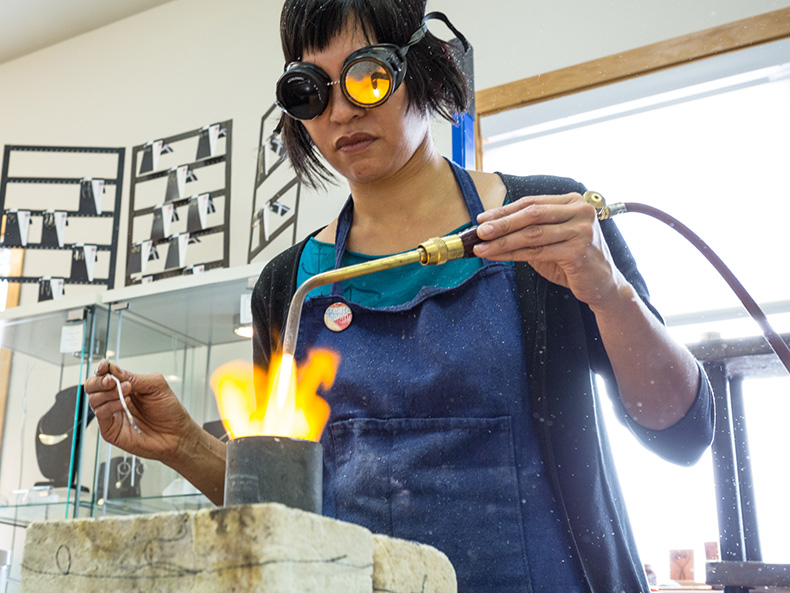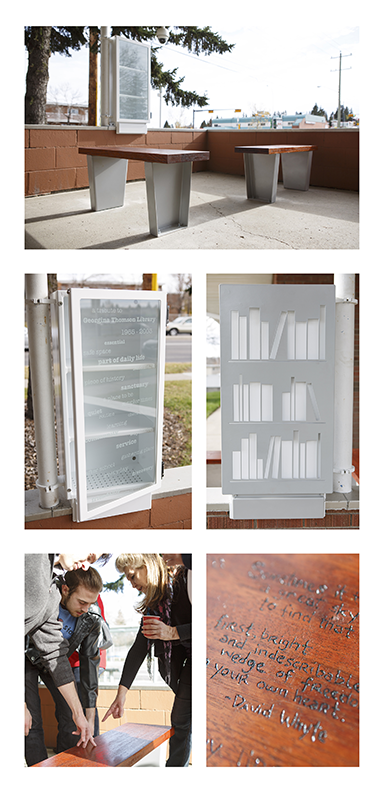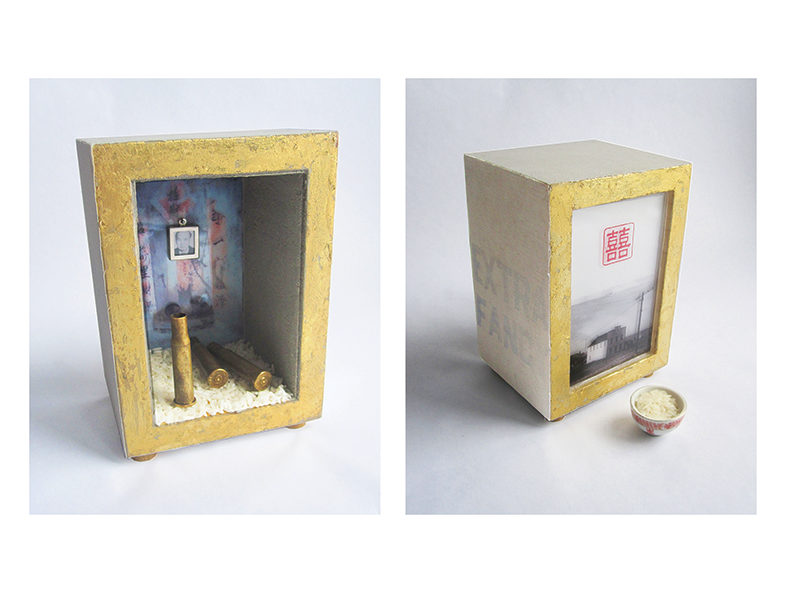Jewellery Designer and Mixed Media Artist
AUArts Alum 2003, BFA | Jewellery & Metals

AUArts: Currently, you are a jewellery designer and a mixed media artist in Canmore?
Kari Woo: That’s correct.
AUArts: Can you tell me more about what you do?
Woo: I have a production line that I design and produce, but I also have help from some AUArts alumni. I’ve probably worked with at least half a dozen alumni from AUArts’ Jewellery department, and with their assistance, I’m able to maintain that production line.
That's been great relationship building and a little bit of mentoring. It’s helped me, and I hope it’s helped the folks I’ve been working with.
As an artist, you become an entrepreneur largely by default. It's impossible to do everything yourself. I'm grateful that there’s a skill pool to pull from in Calgary because of the Jewellery program.
AUArts: That’s amazing. And your lines are sold in different retail stores?
Woo: Yes. My production line, I sell online, through markets and trade shows as well as in boutiques and galleries or design shops. That’s just one major arm of my studio practice and is really my bread and butter.
In the last number of years, I transitioned out of doing so many markets and trade shows to doing custom work, and that has allowed me to stay home more, which has been great. So that's been a big part of my practice the last few years – custom jewellery work.
And in between all of that, I try to make time for exhibition work. So that will be the mixed media work that I do. I have a pretty consistent exhibition record through the years. It hasn't been my main focus, but it's been active.

AUArts: Can you tell me about the New Craft Coalition?
Woo: I've been a part of a number of partnerships since I left AUArts, and all of them have been with AUArts alumni. Some of them we partner and create events, and that's how New Craft Coalition was born with two other alumni, Natalie Gerber and Laura Sharp.
We all felt like we needed to curate our audience a little bit. We were all participating in big trade shows, where the gamut of product at the trade shows really dilutes the handmade kind of objects. So we decided to start this show.
We started it in 2013, and it was fashioned after another collective show that I've been running for years in Vancouver. It was a collaborative effort to bring folks like us, mid-career professional practitioners, together in the realm of art, craft and design, and have a small, curated show. We had a really amazing audience that supported what people were doing. It helped to promote the work of other artists and help propel those people’s careers, and then the other benefit of it was just being able to get together.
I think we would have anywhere between 25 and 30 vendors per show because it was always a small venue, and the relationships you make at the shows in terms of peer review or support were pretty awesome, because we all work on our stuff in little silos.
And you know, most of the artists that we had through just raved about how people responded to their work through that show. Which indicated to us that we were attracting the right people.
AUArts: That sounds great. What a great way to connect and collaborate with people in the industry and people that you went to school with, to come together as a community that way.
Woo: Yes, I think it was important to us to create a context and stage for the work, because sometimes when you see work in a gallery… galleries are intimidating for a large number of people to go to. Creating this environment was great for people to be able to get some exposure and talk to their audience face to face, and not be an intimidating kind of space for people.
AUArts: I read in the previous Viewbook, you said as a kid you would redesign your mom's costume jewellery pieces?
Woo: Exactly. Deconstruct and reconstruct those.

AUArts: Did you know early then, that you had a passion in jewellery or design?
Woo: I don't know that it was ever named; I guess I was always working with my hands as a kid. I did have pressure from my family to go different routes, more professional and higher paying jobs. Doctor, dentist, lawyer, but that was not my forte and I didn't even attempt to do that. There was a lot of tension for a lot of years, but they're okay with it now.
In fact, nowadays, they're my biggest supporters. I depend on them a lot. Even still now, whether it's taking care of my son when I'm at an event or helping with the odds and ends of entrepreneurial life.
My dad, being a real estate agent, was basically an entrepreneur, and I come from a long line of entrepreneurs on both sides of my family. Both of my great grandfathers were storeowners, and even my grandpa had the general corner store. So that entrepreneurial piece has always been in my family.
AUArts: Were you taking something else before you went into Jewellery & Metals?
Woo: I had gone to U of C and done my foundational training in Fine Arts. I took all of the arts courses I could possibly take without declaring a major, because I was still under that kind of pressure, struggling with what to do.
And then I actually took a break; University of Calgary wasn't the right art institution for me. And I took a night class for jewellery through the AUArts extended study program at the time and just fell in love with it.
It really brought me back to working with my hands. You asked earlier if I'd always known. I always knew I wanted to be in the arts, but I didn't even know jewellery was something I could get trained in.
On a whim I decided to take a class, and that just set me on a course. The first night of that class, I remember touching the material and feeling like I had done it before. It just felt so familiar.
I carried on and did my own thing, kind of self-taught a little bit for a few years. But I reached a point where I needed to be somewhere where I could focus and develop my skills. I'd gone as far as I could without any training.
AUArts: And then when you graduated, you worked at a jewellery gallery for a while?
Woo: In 2003, I graduated. That same year I started, in collaboration with three other artists, two of which are also AUArts alumni – Devon Clark and Shona Rae – the INFLUX Jewellery Gallery. We conceptualized, built and opened the gallery. It was an art jewellery gallery, and we represented art jewellers from across the country.
I think at the peak, we had between 35 and 40 artists that we were representing. We worked together for six years, owning and operating that gallery. And in that time, we had an AUArts scholarship program. We also hosted the AUArts Jewellery & Metals department Grad Shows.
AUArts: You mentioned that you come from a long line of entrepreneurs, and you are obviously very driven that way. Is that also something you learned from AUArts?
Woo: The Jewellery & Metals department was really great. There was focus on professional presentation and some coaching on how to approach galleries or boutiques, build your portfolios and such.
They didn't really shy away from the conversation about the commercial aspect of a jewellery practice. It was part of the language in the jewellery department. Not that they pushed everybody to do that, but certainly there was the opportunity to learn those things if you wanted to.
The Jewellery & Metals department was really great. There was focus on professional presentation and some coaching on how to approach galleries or boutiques, build your portfolios and such.
They didn't really shy away from the conversation about the commercial aspect of a jewellery practice. It was part of the language in the jewellery department. Not that they pushed everybody to do that, but certainly there was the opportunity to learn those things if you wanted to.
And then, of course, there was the Show and Sale, which happened every year. I think it’s twice a year now.
I was an active participant, and I volunteered to help coordinate the Jewellery & Metals department table. That was almost like the early beginnings of my activity in terms of Influx and these other events that I've been a part of.
And the folks that I actually ended up opening Influx Jewellery Gallery with were colleagues from the Jewellery & Metals department; I remember we used to coordinate our Show and Sale table together. So that kind of naturally grew into other projects.

AUArts: It feels like there’s a really strong sense of community that you had at AUArts, and you continue to be in that community and contribute to it, with your mentorship and opportunities with your work.
Woo: It’s important, you know? We can't exist alone. So yes, the community's important. I've made efforts to build it in the capacities that I know how to.
AUArts: What was the most important thing that you learned at AUArts?
Woo: I think it's the process of creative problem-solving. I have friends that I made at AUArts that aren't practicing artists at all. But, I see how the skills that they gained in obtaining a Bachelor of Fine Arts degree help them in their daily life, in terms of creative problem-solving. You are learning how to approach problems in unconventional ways, trying to think of different angles on how to solve a problem.
No matter what industry or role you're in, you can still take those problem-solving and critical thinking skills with you.
Absolutely. There’s lots of research out there now that indicates that people who are able to think creatively are more desirable in other sectors of business and industry. I see other industries that are appropriating craft and art language now.
It's something that permeates business and culture.
It’s an approach to life, basically.
I think it's the process of creative problem-solving. I have friends that I made at AUArts that aren't practicing artists at all. But, I see how the skills that they gained in obtaining a Bachelor of Fine Arts degree help them in their daily life, in terms of creative problem-solving. You are learning how to approach problems in unconventional ways, trying to think of different angles on how to solve a problem.
No matter what industry or role you're in, you can still take those problem-solving and critical thinking skills with you.
There’s lots of research out there now that indicates that people who are able to think creatively are more desirable in other sectors of business and industry. I see other industries that are appropriating craft and art language now.
AUArts: Looking back, if you were to talk to yourself in high school, what would you tell yourself?
Woo: I think probably just to be more confident. Don’t doubt yourself so much, and stick to your vision. Even now, there are so many competing opinions out there in the world. Stay true to your vision and what you're good at.

AUArts: Was there anything else that you wanted to share?
Woo: I’m working with some other artists in the region to develop a metal arts facility, which is going to focus on jewellery, blacksmithing and have a foundry. We’re going to be doing bronze and iron casting.
We haven't found another facility in Canada that offers these kinds of creative spaces or services to artists specifically. It’d be open to the general public, but I think that there's going to be great benefit for the metal arts community in Canada. Just be able to have access to these types of tools and facilities that we've got planned.
